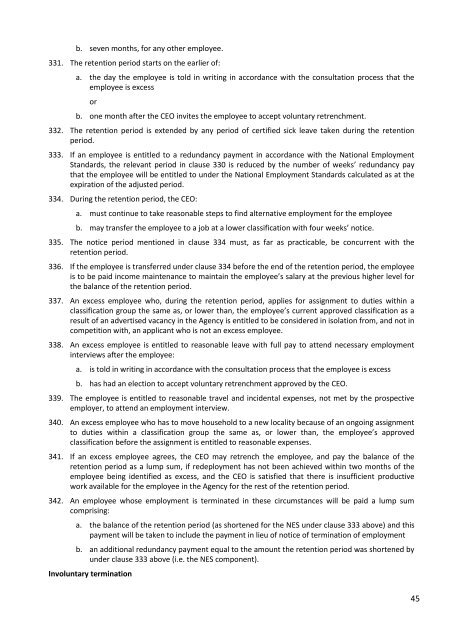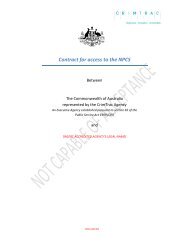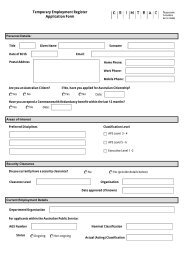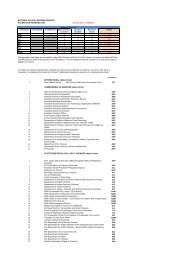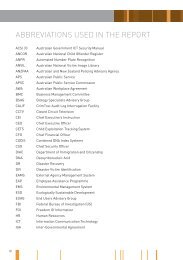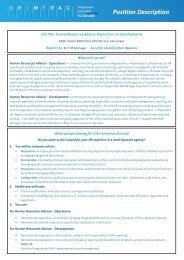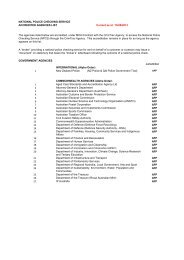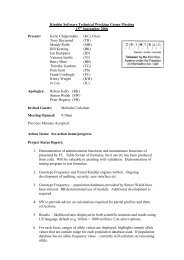CrimTrac Enterprise Agreement 2011-2014
CrimTrac Enterprise Agreement 2011-2014
CrimTrac Enterprise Agreement 2011-2014
You also want an ePaper? Increase the reach of your titles
YUMPU automatically turns print PDFs into web optimized ePapers that Google loves.
. seven months, for any other employee.<br />
331. The retention period starts on the earlier of:<br />
a. the day the employee is told in writing in accordance with the consultation process that the<br />
employee is excess<br />
or<br />
b. one month after the CEO invites the employee to accept voluntary retrenchment.<br />
332. The retention period is extended by any period of certified sick leave taken during the retention<br />
period.<br />
333. If an employee is entitled to a redundancy payment in accordance with the National Employment<br />
Standards, the relevant period in clause 330 is reduced by the number of weeks’ redundancy pay<br />
that the employee will be entitled to under the National Employment Standards calculated as at the<br />
expiration of the adjusted period.<br />
334. During the retention period, the CEO:<br />
a. must continue to take reasonable steps to find alternative employment for the employee<br />
b. may transfer the employee to a job at a lower classification with four weeks’ notice.<br />
335. The notice period mentioned in clause 334 must, as far as practicable, be concurrent with the<br />
retention period.<br />
336. If the employee is transferred under clause 334 before the end of the retention period, the employee<br />
is to be paid income maintenance to maintain the employee’s salary at the previous higher level for<br />
the balance of the retention period.<br />
337. An excess employee who, during the retention period, applies for assignment to duties within a<br />
classification group the same as, or lower than, the employee’s current approved classification as a<br />
result of an advertised vacancy in the Agency is entitled to be considered in isolation from, and not in<br />
competition with, an applicant who is not an excess employee.<br />
338. An excess employee is entitled to reasonable leave with full pay to attend necessary employment<br />
interviews after the employee:<br />
a. is told in writing in accordance with the consultation process that the employee is excess<br />
b. has had an election to accept voluntary retrenchment approved by the CEO.<br />
339. The employee is entitled to reasonable travel and incidental expenses, not met by the prospective<br />
employer, to attend an employment interview.<br />
340. An excess employee who has to move household to a new locality because of an ongoing assignment<br />
to duties within a classification group the same as, or lower than, the employee’s approved<br />
classification before the assignment is entitled to reasonable expenses.<br />
341. If an excess employee agrees, the CEO may retrench the employee, and pay the balance of the<br />
retention period as a lump sum, if redeployment has not been achieved within two months of the<br />
employee being identified as excess, and the CEO is satisfied that there is insufficient productive<br />
work available for the employee in the Agency for the rest of the retention period.<br />
342. An employee whose employment is terminated in these circumstances will be paid a lump sum<br />
comprising:<br />
a. the balance of the retention period (as shortened for the NES under clause 333 above) and this<br />
payment will be taken to include the payment in lieu of notice of termination of employment<br />
b. an additional redundancy payment equal to the amount the retention period was shortened by<br />
under clause 333 above (i.e. the NES component).<br />
Involuntary termination<br />
45


